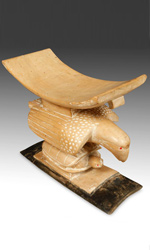Sitting on Gold – Ashanti Stools
PRIMITIVE - Friday, June 03, 2016Edited by Glen Joffe
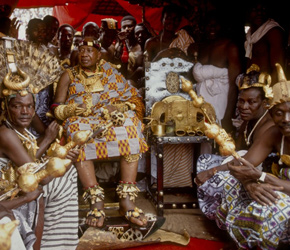 |
|
Writer’s note: Back when I was researching Kente cloths from the Ashanti Kingdom of present day Ghana, I came across an intriguing story, which I promised to revisit one day. It was called the legend of the Golden Stool. The preface to the story requires a bit of Ashanti history. Briefly, the Ashanti Kingdom began as a loose confederation of Akan speaking clans united against the oppression of the Denkyira Kingdom, a nation demanding excessive yearly tributes. Led by Osei Tutu, chief of the state of Kumasi, the coalition defeated the Denkyira and the Ashanti kingdom was founded in 1701. However, according to legend, the most dramatic and significant moment in their founding history occurred on the eve of the final, decisive battle against the Denkyira.
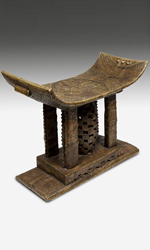 |
|
As the Ashanti chiefs gathered for a strategic meeting the anticipation of certain victory was almost tangible. Several chiefs were already whispering among themselves about the plans they had for their states after the Denkyira were overthrown. Osei Tutu arrived with his trusted advisor and priest, Okomfo Anokye, and sat before the chiefs. Anokye was greatly respected as a wise prophet. Many chiefs believed he could commune with the gods. As evening approached, Anokye began an incantation before the gathered chiefs, his voice gradually growing stronger and increasingly feverish until he was shouting and ranting at the heavens. Thunder rumbled and clouds darker than night gathered overhead. A flash of lightning blinded the awe-struck chiefs and when they looked up again a golden stool appeared, floating down from heaven. Mesmerized, they followed its slow descent until it landed softly on Osei Tutu's knees.
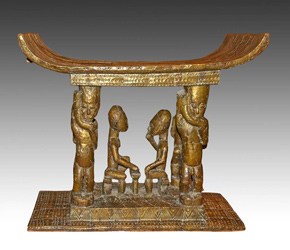 |
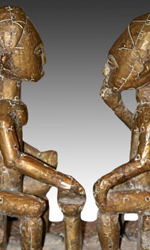 |
|
No one dared move. A long period of silence followed. Then Anokye, in a low, hoarse voice declared this stool contained the soul of the Ashanti people and forevermore would become the symbol of their new kingdom. At that moment every chief swore allegiance to the stool and Osei Tutu as their first Asantehene, or king. All thoughts of defecting from the union following Denkyira's defeat were dispersed, and the loyalty and commitment to the new Ashanti Kingdom was inexorable. Since that day, the Golden Stool has been considered a sacred object to be protected by the Ashanti at all costs. Even today, only the king and a select few advisors know exactly where the Stool is hidden. Only on the most important and prestigious occasions is it brought out, and then it sits on a seat of its own. The stool is never allowed to touch the ground and no one is ever permitted to sit in it – not even the king! In fact, when a British governor once ignorantly demanded to sit in it, the Ashanti took such offense that they declared war!
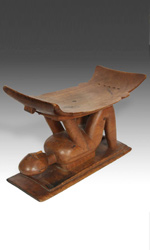 |
|
While the exact origin of the Golden Stool is unknown outside of legends, it came to symbolize the central role of carved wooden stools in the Ashanti culture. Not only are they functional objects, but also integral to Ashanti spiritual and religious customs. The Ashanti believed a person's soul inhabited his or her stool. When the stools were not in use, they were tilted onto their sides so that other spirits – especially evil ones – could not take up residence. From birth to death, stools mark important life events: one of the earliest gifts an Ashanti boy receives from his father is a stool; when an Ashanti girl reaches puberty she is presented with a stool; men gift stools to their brides-to-be as engagement promises; and when a person dies, his or her stool is placed in a shrine and becomes an object of ancestor veneration.
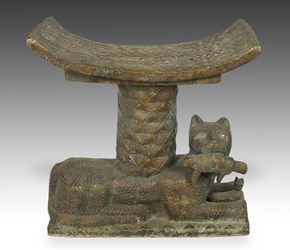 |
|
Carvers were bestowed a great honor when they were commissioned to craft stools for chiefs, priests and other high-ranking members of Ashanti society. Not only does the carving of a stool require exceptional skill and imagination, but also an understanding of the Ashanti moral codes and their unique visual language. Like all other forms of Ashanti art, stools feature meaningful forms and geometric designs that convey messages about the status and importance of the owner. For example, the Asantehene and associated chiefs sat on stools designed with the figures of elephants, leopards and feline predators, which symbolized the strength and authority of their owners. No one else was permitted to use those royal motifs. Stools covered in gold or silver leaf were also the prerogative of the king and queen or a chief and his wives. Owning many stools was an indicator of high status, some with figurative carvings and others with geometric patterns.
Many designs incorporated visual representations of Ashanti proverbs. In the Ashanti language, there are more than 3,600 proverbs dealing with every aspect of tribal life. These proverbs are considered the repository of Ashanti wisdom and were often expressed by skilled craftsmen in their sculpture. For example, a bird perched on top of a tortoise may refer to the proverb: The fowl says, Pluck the tortoise, but the tortoise says, You will tire of trying! Sometimes, as in this case, the meaning of proverbs remained open to interpretation, thus inviting further examination and discourse among the people. As Christianity and modern technology arrived in the country, innovative motifs also emerged, such as images of the cross and Mother Mary as well as stools depicting airplanes. Even today, stools are still regarded as one of the most important aspects of Ashanti heritage. They are not just furniture or seating – but art, and in most cases, art that is sacred to the people and their leaders.
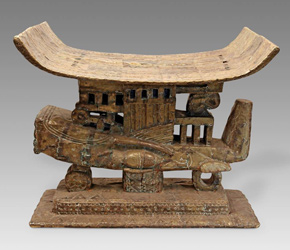 |
|
Although other African nations consider the stool an important spiritual object and symbol of leadership, few attribute it with such sacred significance and aesthetic devotion as the Ashanti. As objects of such prominence, many Ashanti stools have been both well used and safeguarded. Most have a warm, smooth patina attesting to their integral history in the lives of the Ashanti people. An old saying states, "There are no secrets between a man and his stool." Right through to the present day since the founding of the Ashanti Kingdom, these stools continue to exude an aura of mystery and majesty, insuring they will remain one of the most collectible objects in all of African art.
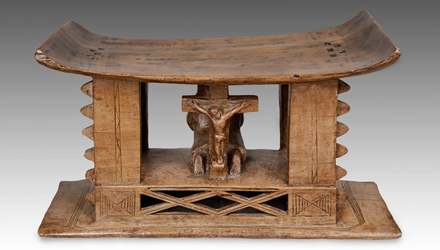 |
Download this Article: Sitting on Gold – Ashanti Stools.pdf
